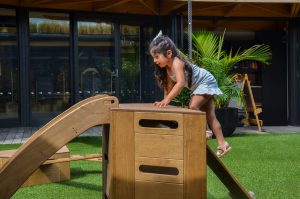By Kurt Woodman – Outdoor Play Visionary
In a world increasingly obsessed with safety and control, “risky play” can sound like a contradiction. But the truth is: when thoughtfully designed and supported, risky play is not about danger — it’s about development. It’s the scaffold on which confidence, resilience, and adaptive intelligence are built.
What Is Risky Play?
Risky play involves activities where children test their physical and emotional limits. These might include:
It’s not recklessness. It’s intentional. It’s exploration at the edges of comfort — where learning happens most powerfully.
As Nathan Wallis, leading neuroscience educator, puts it:
“The frontal cortex develops through experience — trial, error, and repetition. Risky play gives children the opportunity to make decisions, assess danger, and solve problems in real time.”
In other words: children need exposure to challenges to grow smarter, stronger, and more self-aware.
The Neuroscience of Risk
Neuroscience tells us the frontal cortex — responsible for executive function, emotional regulation, and strategic decision-making — is shaped by active experience. Not passive instruction. Not worksheets. Play.
Risky play creates conditions for:
When children wobble across a log or climb a high platform, they’re not just burning energy. They’re building a sense of self-efficacy — the belief that “I can try, fail, learn, and succeed.”
Confidence isn’t taught. It’s earned, through lived experience.
The Problem with Overprotection
In an effort to protect children, many environments unintentionally remove the very experiences that help them thrive.
When climbing frames shrink, surfaces flatten, and adult intervention interrupts every risk, we don’t eliminate harm — we eliminate growth.
Research shows overprotected children are more likely to:
By contrast, children who experience safe, supported risk develop:
Design that Supports Discovery
At Outdorable, we don’t just permit risky play — we design for it. Our play packages are modular, natural, and open-ended so children can:
Every plank, log, branch and slide is a conversation starter between the child and the environment — a quiet invitation to try, rethink, try again.
Safety still matters. But challenge matters more. We build for both.
What Educators Can Do
Educators play a vital role in facilitating risky play. That doesn’t mean watching from a distance or taking over a child’s decision. It means:
Wallis reminds us:
“Frontal cortex development comes through the act of ‘doing’. The more chances children have to make decisions and solve problems, the better equipped they are for life.”
Risky play is one of the most powerful ways to provide that.
Let’s stop asking “Is this safe?”
Let’s start asking, “Is this challenging enough?”
Because it’s in the climb, the fall, and the brave try again — that confidence is born.
“The mud will wash off, but the memories will last a lifetime.”
— Kurt Woodman, Outdoor Play Visionary
